Pumping Station Desing - Second Edition by Robert L. Sanks, George Tchobahoglous, Garr M. Jones
Подождите немного. Документ загружается.

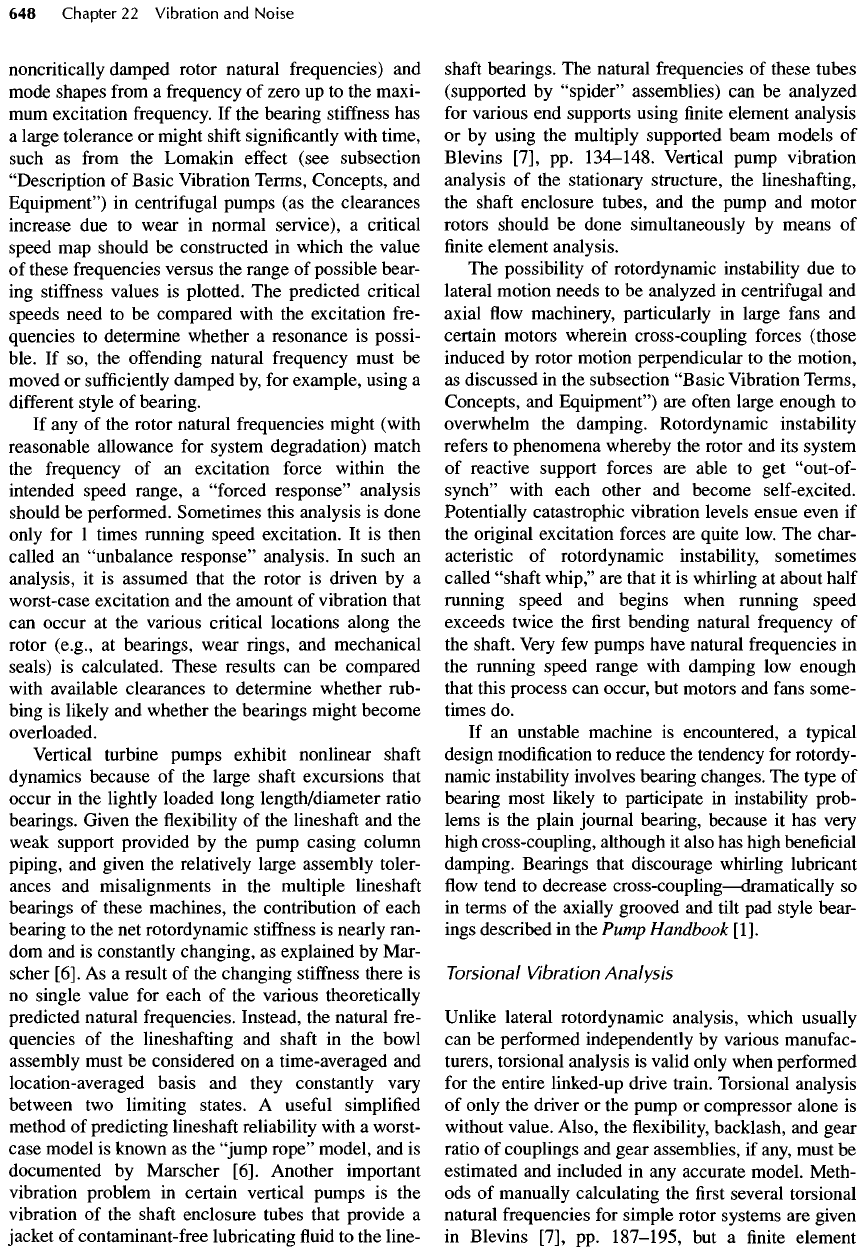
noncritically damped rotor natural frequencies)
and
mode shapes
from
a
frequency
of
zero
up to the
maxi-
mum
excitation
frequency.
If the
bearing
stiffness
has
a
large tolerance
or
might
shift
significantly
with time,
such
as
from
the
Lomakin
effect
(see subsection
"Description
of
Basic Vibration Terms, Concepts,
and
Equipment")
in
centrifugal
pumps
(as the
clearances
increase
due to
wear
in
normal service),
a
critical
speed
map
should
be
constructed
in
which
the
value
of
these frequencies versus
the
range
of
possible bear-
ing
stiffness
values
is
plotted.
The
predicted
critical
speeds need
to be
compared with
the
excitation fre-
quencies
to
determine whether
a
resonance
is
possi-
ble.
If so, the
offending
natural frequency must
be
moved
or
sufficiently
damped
by, for
example, using
a
different
style
of
bearing.
If
any of the
rotor natural frequencies might (with
reasonable allowance
for
system degradation) match
the
frequency
of an
excitation
force
within
the
intended
speed range,
a
"forced
response"
analysis
should
be
performed. Sometimes this analysis
is
done
only
for 1
times running speed excitation.
It is
then
called
an
"unbalance
response"
analysis.
In
such
an
analysis,
it is
assumed that
the
rotor
is
driven
by a
worst-case excitation
and the
amount
of
vibration that
can
occur
at the
various critical locations along
the
rotor (e.g.,
at
bearings, wear rings,
and
mechanical
seals)
is
calculated. These results
can be
compared
with
available clearances
to
determine whether rub-
bing
is
likely
and
whether
the
bearings might become
overloaded.
Vertical
turbine pumps exhibit nonlinear
shaft
dynamics
because
of the
large
shaft
excursions that
occur
in the
lightly loaded long length/diameter ratio
bearings. Given
the flexibility of the
lineshaft
and the
weak
support provided
by the
pump casing column
piping,
and
given
the
relatively large assembly toler-
ances
and
misalignments
in the
multiple
lineshaft
bearings
of
these machines,
the
contribution
of
each
bearing
to the net
rotordynamic
stiffness
is
nearly ran-
dom
and is
constantly changing,
as
explained
by
Mar-
scher
[6].
As a
result
of the
changing
stiffness
there
is
no
single value
for
each
of the
various theoretically
predicted natural frequencies. Instead,
the
natural fre-
quencies
of the
lineshafting
and
shaft
in the
bowl
assembly
must
be
considered
on a
time-averaged
and
location-averaged basis
and
they constantly vary
between
two
limiting states.
A
useful
simplified
method
of
predicting
lineshaft
reliability with
a
worst-
case model
is
known
as the
"jump
rope"
model,
and is
documented
by
Marscher
[6].
Another important
vibration
problem
in
certain vertical pumps
is the
vibration
of the
shaft
enclosure tubes that provide
a
jacket
of
contaminant-free lubricating
fluid to the
line-
shaft
bearings.
The
natural frequencies
of
these tubes
(supported
by
"spider"
assemblies)
can be
analyzed
for
various
end
supports using
finite
element analysis
or by
using
the
multiply supported beam models
of
Blevins [7],
pp.
134-148.
Vertical pump vibration
analysis
of the
stationary structure,
the
lineshafting,
the
shaft
enclosure tubes,
and the
pump
and
motor
rotors should
be
done simultaneously
by
means
of
finite
element analysis.
The
possibility
of
rotordynamic instability
due to
lateral motion needs
to be
analyzed
in
centrifugal
and
axial
flow
machinery, particularly
in
large
fans
and
certain motors wherein cross-coupling forces (those
induced
by
rotor motion perpendicular
to the
motion,
as
discussed
in the
subsection
"Basic
Vibration Terms,
Concepts,
and
Equipment")
are
often
large enough
to
overwhelm
the
damping. Rotordynamic instability
refers
to
phenomena whereby
the
rotor
and its
system
of
reactive support forces
are
able
to get
"out-of-
synch"
with each other
and
become self-excited.
Potentially catastrophic vibration levels ensue even
if
the
original excitation forces
are
quite low.
The
char-
acteristic
of
rotordynamic instability, sometimes
called "shaft whip,"
are
that
it is
whirling
at
about half
running speed
and
begins when running speed
exceeds twice
the first
bending natural
frequency
of
the
shaft.
Very
few
pumps have natural frequencies
in
the
running speed range with damping
low
enough
that
this process
can
occur,
but
motors
and
fans
some-
times
do.
If
an
unstable machine
is
encountered,
a
typical
design modification
to
reduce
the
tendency
for
rotordy-
namic instability involves bearing changes.
The
type
of
bearing most likely
to
participate
in
instability prob-
lems
is the
plain journal bearing, because
it has
very
high cross-coupling, although
it
also
has
high beneficial
damping. Bearings that discourage whirling lubricant
flow
tend
to
decrease
cross-coupling
—
dramatically
so
in
terms
of the
axially grooved
and
tilt
pad
style bear-
ings described
in the
Pump
Handbook
[I].
Torsional
Vibration Analysis
Unlike lateral rotordynamic analysis, which usually
can be
performed independently
by
various manufac-
turers, torsional analysis
is
valid only when performed
for
the
entire
linked-up
drive train. Torsional analysis
of
only
the
driver
or the
pump
or
compressor alone
is
without
value. Also,
the flexibility,
backlash,
and
gear
ratio
of
couplings
and
gear assemblies,
if
any, must
be
estimated
and
included
in any
accurate model. Meth-
ods of
manually calculating
the first
several torsional
natural
frequencies
for
simple rotor systems
are
given
in
Blevins [7],
pp.
187-195,
but a finite
element
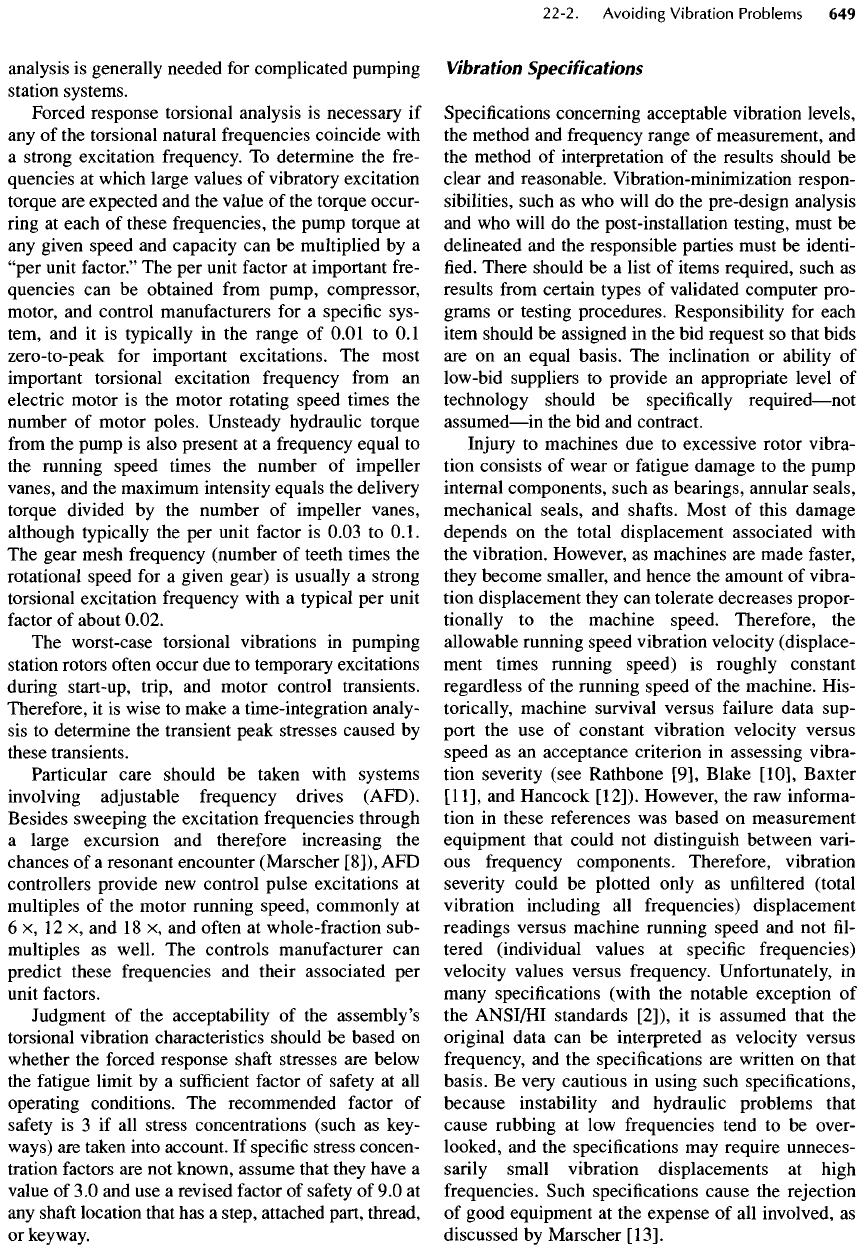
analysis
is
generally needed
for
complicated pumping
station systems.
Forced
response torsional analysis
is
necessary
if
any
of the
torsional natural frequencies coincide with
a
strong excitation
frequency.
To
determine
the
fre-
quencies
at
which large values
of
vibratory excitation
torque
are
expected
and the
value
of the
torque occur-
ring
at
each
of
these frequencies,
the
pump torque
at
any
given speed
and
capacity
can be
multiplied
by a
"per unit factor."
The per
unit
factor
at
important fre-
quencies
can be
obtained
from
pump, compressor,
motor,
and
control manufacturers
for a
specific
sys-
tem,
and it is
typically
in the
range
of
0.01
to 0.1
zero-to-peak
for
important excitations.
The
most
important torsional excitation frequency
from
an
electric motor
is the
motor rotating speed times
the
number
of
motor poles. Unsteady hydraulic torque
from
the
pump
is
also present
at a
frequency
equal
to
the
running speed times
the
number
of
impeller
vanes,
and the
maximum intensity equals
the
delivery
torque divided
by the
number
of
impeller vanes,
although
typically
the per
unit factor
is
0.03
to
0.1.
The
gear mesh
frequency
(number
of
teeth times
the
rotational speed
for a
given gear)
is
usually
a
strong
torsional excitation frequency with
a
typical
per
unit
factor
of
about 0.02.
The
worst-case torsional vibrations
in
pumping
station rotors
often
occur
due to
temporary excitations
during
start-up, trip,
and
motor control transients.
Therefore,
it is
wise
to
make
a
time-integration analy-
sis
to
determine
the
transient peak stresses caused
by
these transients.
Particular care should
be
taken with systems
involving
adjustable frequency drives (AFD).
Besides sweeping
the
excitation frequencies through
a
large excursion
and
therefore increasing
the
chances
of a
resonant encounter (Marscher
[8]),
AFD
controllers provide
new
control pulse excitations
at
multiples
of the
motor running speed, commonly
at
6 x, 12 x, and
18
x, and
often
at
whole-fraction sub-
multiples
as
well.
The
controls manufacturer
can
predict these frequencies
and
their associated
per
unit
factors.
Judgment
of the
acceptability
of the
assembly's
torsional vibration characteristics should
be
based
on
whether
the
forced response
shaft
stresses
are
below
the
fatigue limit
by a
sufficient
factor
of
safety
at all
operating conditions.
The
recommended
factor
of
safety
is 3 if all
stress concentrations (such
as
key-
ways)
are
taken into account.
If
specific
stress concen-
tration
factors
are not
known, assume that they have
a
value
of 3.0 and use a
revised factor
of
safety
of 9.0 at
any
shaft
location that
has a
step, attached part, thread,
or key
way.
Vibration Specifications
Specifications
concerning acceptable vibration levels,
the
method
and
frequency
range
of
measurement,
and
the
method
of
interpretation
of the
results should
be
clear
and
reasonable. Vibration-minimization respon-
sibilities, such
as who
will
do the
pre-design analysis
and
who
will
do the
post-installation testing, must
be
delineated
and the
responsible parties must
be
identi-
fied.
There should
be a
list
of
items required, such
as
results
from
certain types
of
validated computer pro-
grams
or
testing procedures. Responsibility
for
each
item should
be
assigned
in the bid
request
so
that bids
are on an
equal basis.
The
inclination
or
ability
of
low-bid suppliers
to
provide
an
appropriate level
of
technology should
be
specifically
required
—
not
assumed
—
in
the bid and
contract.
Injury
to
machines
due to
excessive rotor vibra-
tion consists
of
wear
or
fatigue damage
to the
pump
internal components, such
as
bearings, annular seals,
mechanical seals,
and
shafts.
Most
of
this damage
depends
on the
total displacement associated with
the
vibration. However,
as
machines
are
made
faster,
they become smaller,
and
hence
the
amount
of
vibra-
tion displacement they
can
tolerate decreases propor-
tionally
to the
machine
speed.
Therefore,
the
allowable running speed vibration velocity (displace-
ment times running speed)
is
roughly constant
regardless
of the
running speed
of the
machine. His-
torically, machine survival versus failure data sup-
port
the use of
constant vibration velocity versus
speed
as an
acceptance criterion
in
assessing vibra-
tion
severity (see
Rathbone
[9], Blake [10], Baxter
[11],
and
Hancock
[12]).
However,
the raw
informa-
tion
in
these references
was
based
on
measurement
equipment that could
not
distinguish between vari-
ous
frequency components. Therefore, vibration
severity could
be
plotted only
as
unfiltered
(total
vibration including
all
frequencies) displacement
readings versus machine running speed
and not
fil-
tered (individual values
at
specific
frequencies)
velocity values versus frequency. Unfortunately,
in
many
specifications (with
the
notable exception
of
the
ANSI/HI
standards
[2]),
it is
assumed that
the
original data
can be
interpreted
as
velocity versus
frequency,
and the
specifications
are
written
on
that
basis.
Be
very cautious
in
using such specifications,
because instability
and
hydraulic problems that
cause rubbing
at low
frequencies tend
to be
over-
looked,
and the
specifications
may
require unneces-
sarily small vibration displacements
at
high
frequencies.
Such specifications cause
the
rejection
of
good equipment
at the
expense
of all
involved,
as
discussed
by
Marscher
[13].

Typical
specifications
for
pumping stations
to
establish vibration test types, measurement locations,
and
acceptance criteria
are
contained
in the
ANSI/HI
standards [2],
API 610
[14],
MiI-STD-
167-1
(Ships)
[15],
and
various
ISO
machinery vibration specifica-
tions, such
as ISO
2372
[16].
These specifications
require
the
monitoring
of
bearing housing vibration
by
using
an
accelerometer
or
velocity probe
in
three
perpendicular
directions
at the
location
of
each
of the
bearings
in the
drive train.
The
acceleration readings
are
typically integrated
to
obtain vibration displace-
ment
and/or velocity
values
—
the
typical terms
for the
criteria. Occasionally,
the
specifications contain pro-
cedures
for the
installation
and
evaluation
of
shaft
proximity
probes mounted
in
some bearing housings
to
measure
shaft
versus housing displacement.
Acceptability
criteria varies between
the
various
specifications.
A
conservative approach, consistent
with
all of the
quoted specifications,
is to
require that
vibration
does
not
exceed
any of
these three criteria
at
any
frequency:
0.05
mm
(2.0 mils) displacement
peak-to-peak,
6
mm/s (0.25 in./s) zero-to-peak
(or
just
peak)
velocity,
and
1
.0
g
peak acceleration.
In
essence, vibration velocity
can be
thought
of as
displacement
times
the
frequency
at
which
it
occurs
times
a
scaling constant. Likewise, acceleration
can be
thought
of as
displacement times
frequency
squared,
times
a
scaling constant.
The
value
of
scaling con-
stants
is not a key to the
discussion here, although
knowledge that
the
above relationships exist brings
out
the
important point that vibration displacement,
velocity,
and
acceleration
are all
measurements
of the
same quantity,
but
with
different
emphasis given
to
vibration
that occurs
in
different
frequency
ranges.
At
low
frequencies,
for
example, displacement
is the
most
stringent criteria, while
at
high frequencies
acceleration
is the
most stringent. Depending
on the
type
of
equipment, displacement
may be
more likely
to
reject unreliable machines
and
pass reliable
machines
than acceleration would
be. On the
other
hand,
for
machines prone
to
problems that show
up at
high
frequencies (usually
not
true
of
pumping station
equipment)
the
opposite would
be
true. Vibration
velocity
is
used
in
many specifications
as a
"middle-
of-the-road" single acceptance criterion,
but
this prac-
tice
is not
recommended, because
it
tends
to be
blind
to
potential rubs
at low
frequencies
and is too
strin-
gent
as a
general criterion
for
most machinery
at
high
frequencies.
In
practice,
the 1.0 g
peak acceleration
specification
given above
is
less stringent than
the
dis-
placement
and
velocity specifications except
for
high
frequencies.
Generally speaking, high
acceleration
measurement
is
useful
only
as a flag
that there
is
something
unusual (possibly harmless)
in the
system,
and
by
itself does
not
necessarily indicate that there
is
a
problem with
the
machine.
For
vertical pumps,
the
maximum allowable dis-
placement
may be
significantly
higher than 0.05
mm
(2
mils)
due to the
geometrical lever
principle
acting
to
magnify
the
motion associated with
a
tall motor
or
pump
bearing tower (see pages
120 and 121 in the
ANSI/HI
Standards
[2]).
Piping vibration
is in a
special class. Pipes
can be
allowed
to
vibrate
up to
roughly three times that
allowed
for the
machine
to
which
it is
attached (see
Wachel
[17]).
22-3. Troubleshooting
Excessive
Vibration
Vibration
problems
may
sometimes occur
in
existing
stations,
in new
stations because
of
corners
cut
during
the
design
process,
or in new
stations
in
spite
of
fol-
lowing
recommended practice. These problems
can
often
be
solved
by a
combination
of
inspection
and
common sense.
If the
problems persist, then vibration
experts with appropriate vibration measurement
equipment
can be
called
in.
Make sure that these
experts
focus
on
solving
the
problem
at
hand instead
of
just gathering data. Prior
to
calling
in
consultants,
the
following procedures
can
serve
as a
guide,
but be
prepared
to
modify
them
to fit the
particulars
of
your
situation.
Basic
Troubleshooting
Procedures
Obtain
a
history
of the
problem:
is it
recent
or has it
always
occurred?
Has the
system
or its
operation
recently changed?
If the
problem
is
recent
in an
exist-
ing
installation,
it is
likely
to be
caused
by
looseness,
clogging, erosion,
or
wear. Pump disassembly
may be
required
for
answers,
but
even
so,
delay
for the
moment. Before dismantling
the
pump
for
inspection,
follow
the
procedures given below
as far as
conditions
permit,
and
answer
the
following questions:
(1)
Does
the
problem relate
to flow, the
sump level,
or
some
other circumstance?
(2) Is the
vibration constant
or
intermittent?
(3)
Have components been
failing?
(4)
Which locations shake beyond
the
specifications,
and
which
do
not?
(5) Is
there
a
pattern
to the
locations
that
shake and/or make noise?
A
list
of
checking pro-
cedures follows, more
or
less
in the
order
to be
per-
formed.
• A
common
fault
is a
pump operating
off the
bep.
Install
a
calibrated pressure gauge
on the
discharge
and
another
on the
suction pipe. Read static pres-
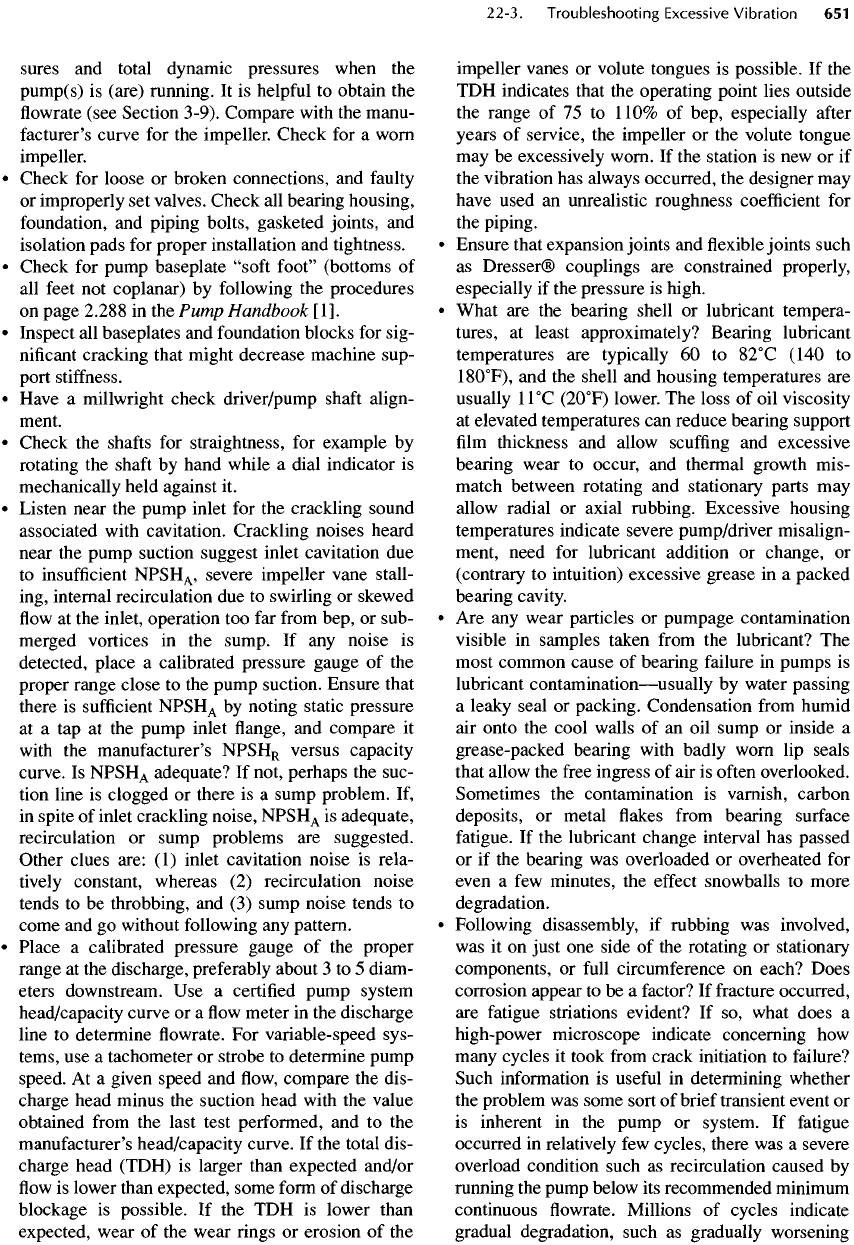
sures
and
total dynamic pressures when
the
pump(s)
is
(are) running.
It is
helpful
to
obtain
the
flowrate
(see Section 3-9). Compare with
the
manu-
facturer's
curve
for the
impeller. Check
for a
worn
impeller.
•
Check
for
loose
or
broken connections,
and
faulty
or
improperly
set
valves. Check
all
bearing housing,
foundation,
and
piping bolts, gasketed joints,
and
isolation
pads
for
proper installation
and
tightness.
•
Check
for
pump baseplate "soft foot" (bottoms
of
all
feet
not
coplanar)
by
following
the
procedures
on
page 2.288
in the
Pump Handbook
[I].
•
Inspect
all
baseplates
and
foundation blocks
for
sig-
nificant
cracking that might decrease machine sup-
port
stiffness.
•
Have
a
millwright check driver/pump
shaft
align-
ment.
•
Check
the
shafts
for
straightness,
for
example
by
rotating
the
shaft
by
hand while
a
dial indicator
is
mechanically
held against
it.
•
Listen near
the
pump inlet
for the
crackling sound
associated with cavitation. Crackling noises heard
near
the
pump suction suggest inlet cavitation
due
to
insufficient
NPSH
A
,
severe impeller vane stall-
ing,
internal recirculation
due to
swirling
or
skewed
flow
at
the
inlet, operation
too far
from
bep,
or
sub-
merged vortices
in the
sump.
If any
noise
is
detected, place
a
calibrated pressure gauge
of the
proper range close
to the
pump suction. Ensure that
there
is
sufficient
NPSH
A
by
noting static pressure
at
a tap at the
pump inlet
flange, and
compare
it
with
the
manufacturer's
NPS
H
R
versus capacity
curve.
Is
NPSH
A
adequate?
If
not, perhaps
the
suc-
tion line
is
clogged
or
there
is a
sump problem.
If,
in
spite
of
inlet crackling noise,
NPSH
A
is
adequate,
recirculation
or
sump problems
are
suggested.
Other clues are:
(1)
inlet cavitation noise
is
rela-
tively
constant, whereas
(2)
recirculation noise
tends
to be
throbbing,
and (3)
sump noise tends
to
come
and go
without following
any
pattern.
•
Place
a
calibrated pressure gauge
of the
proper
range
at the
discharge, preferably about
3 to 5
diam-
eters downstream.
Use a
certified pump system
head/capacity curve
or a flow
meter
in the
discharge
line
to
determine
flowrate. For
variable-speed sys-
tems,
use a
tachometer
or
strobe
to
determine pump
speed.
At a
given speed
and flow,
compare
the
dis-
charge
head minus
the
suction head with
the
value
obtained
from
the
last test performed,
and to the
manufacturer's
head/capacity curve.
If the
total dis-
charge head (TDH)
is
larger than expected and/or
flow
is
lower than expected, some
form
of
discharge
blockage
is
possible.
If the TDH is
lower than
expected, wear
of the
wear rings
or
erosion
of the
impeller vanes
or
volute tongues
is
possible.
If the
TDH
indicates that
the
operating point lies outside
the
range
of 75 to
110%
of
bep, especially
after
years
of
service,
the
impeller
or the
volute tongue
may
be
excessively worn.
If the
station
is new or if
the
vibration
has
always occurred,
the
designer
may
have
used
an
unrealistic roughness
coefficient
for
the
piping.
•
Ensure that expansion joints
and flexible
joints such
as
Dresser®
couplings
are
constrained properly,
especially
if the
pressure
is
high.
•
What
are the
bearing shell
or
lubricant tempera-
tures,
at
least approximately? Bearing lubricant
temperatures
are
typically
60 to
82
0
C
(140
to
18O
0
F),
and the
shell
and
housing temperatures
are
usually
U
0
C
(2O
0
F)
lower.
The
loss
of oil
viscosity
at
elevated temperatures
can
reduce bearing support
film
thickness
and
allow
scuffing
and
excessive
bearing wear
to
occur,
and
thermal growth mis-
match between rotating
and
stationary parts
may
allow
radial
or
axial rubbing. Excessive housing
temperatures indicate severe pump/driver misalign-
ment, need
for
lubricant addition
or
change,
or
(contrary
to
intuition) excessive grease
in a
packed
bearing cavity.
• Are any
wear particles
or
pumpage contamination
visible
in
samples taken
from
the
lubricant?
The
most common cause
of
bearing
failure
in
pumps
is
lubricant
contamination
—
usually
by
water passing
a
leaky seal
or
packing. Condensation
from
humid
air
onto
the
cool
walls
of an oil
sump
or
inside
a
grease-packed bearing with badly worn
lip
seals
that
allow
the
free
ingress
of air is
often
overlooked.
Sometimes
the
contamination
is
varnish, carbon
deposits,
or
metal
flakes
from
bearing
surface
fatigue.
If the
lubricant change interval
has
passed
or if the
bearing
was
overloaded
or
overheated
for
even
a few
minutes,
the
effect
snowballs
to
more
degradation.
•
Following disassembly,
if
rubbing
was
involved,
was
it on
just
one
side
of the
rotating
or
stationary
components,
or
full
circumference
on
each? Does
corrosion appear
to be a
factor?
If
fracture occurred,
are
fatigue
striations evident?
If so,
what does
a
high-power microscope indicate concerning
how
many
cycles
it
took
from
crack initiation
to
failure?
Such
information
is
useful
in
determining whether
the
problem
was
some sort
of
brief transient event
or
is
inherent
in the
pump
or
system.
If
fatigue
occurred
in
relatively
few
cycles, there
was a
severe
overload condition such
as
recirculation caused
by
running
the
pump below
its
recommended minimum
continuous
flowrate.
Millions
of
cycles indicate
gradual degradation, such
as
gradually worsening
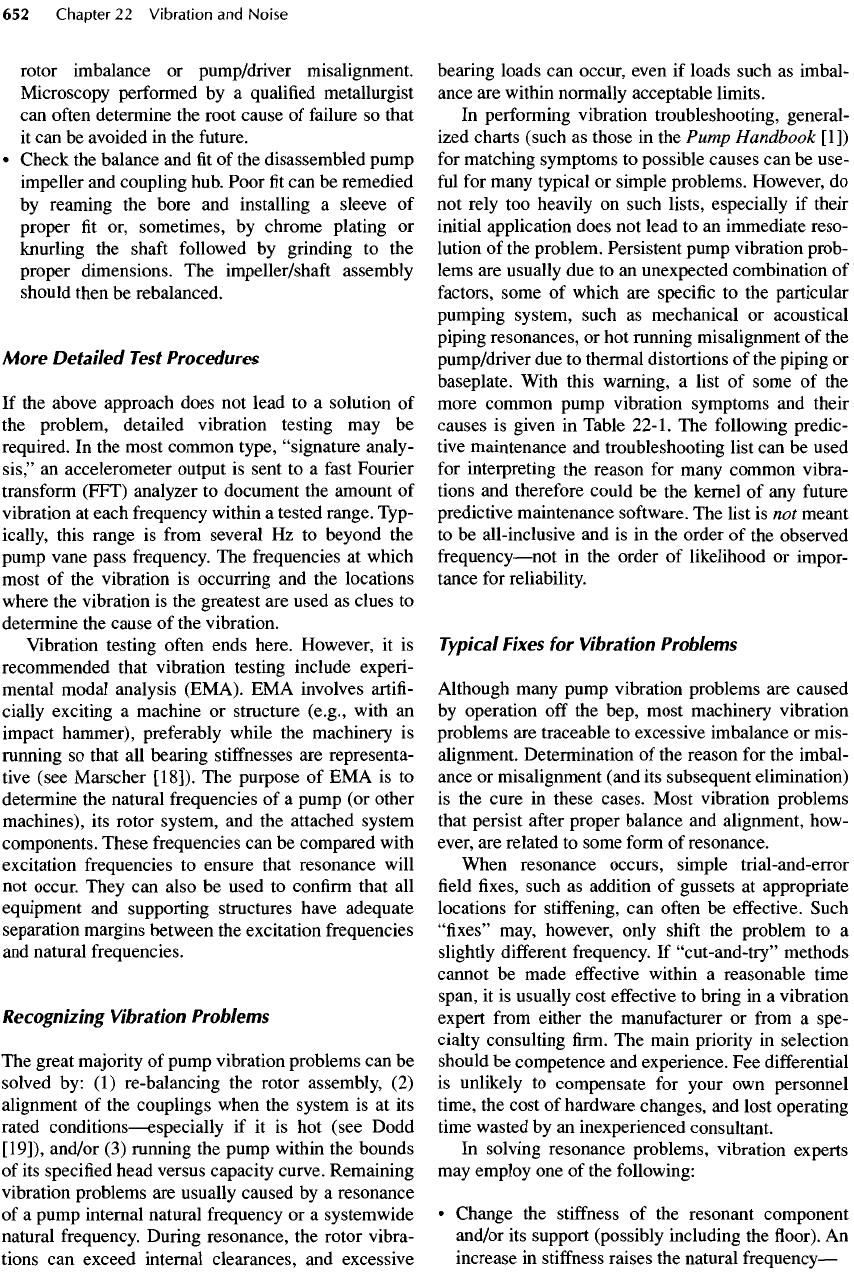
rotor imbalance
or
pump/driver misalignment.
Microscopy performed
by a
qualified metallurgist
can
often
determine
the
root cause
of
failure
so
that
it
can be
avoided
in the
future.
•
Check
the
balance
and fit of the
disassembled pump
impeller
and
coupling hub.
Poor
fit can be
remedied
by
reaming
the
bore
and
installing
a
sleeve
of
proper
fit or,
sometimes,
by
chrome plating
or
knurling
the
shaft
followed
by
grinding
to the
proper dimensions.
The
impeller/shaft assembly
should
then
be
rebalanced.
More
Detailed
Test
Procedures
If
the
above approach does
not
lead
to a
solution
of
the
problem, detailed vibration testing
may be
required.
In the
most common type, "signature analy-
sis,"
an
accelerometer output
is
sent
to a
fast
Fourier
transform
(FFT) analyzer
to
document
the
amount
of
vibration
at
each frequency within
a
tested
range. Typ-
ically, this range
is
from
several
Hz to
beyond
the
pump
vane pass frequency.
The
frequencies
at
which
most
of the
vibration
is
occurring
and the
locations
where
the
vibration
is the
greatest
are
used
as
clues
to
determine
the
cause
of the
vibration.
Vibration
testing
often
ends here. However,
it is
recommended that vibration testing include experi-
mental
modal analysis (EMA).
EMA
involves
artifi-
cially exciting
a
machine
or
structure (e.g., with
an
impact
hammer), preferably while
the
machinery
is
running
so
that
all
bearing
stiffnesses
are
representa-
tive (see Marscher
[18]).
The
purpose
of EMA is to
determine
the
natural frequencies
of a
pump
(or
other
machines),
its
rotor system,
and the
attached system
components.
These
frequencies
can be
compared with
excitation
frequencies
to
ensure that resonance will
not
occur. They
can
also
be
used
to
confirm
that
all
equipment
and
supporting structures have adequate
separation margins between
the
excitation frequencies
and
natural frequencies.
Recognizing
Vibration
Problems
The
great
majority
of
pump vibration problems
can be
solved
by: (1)
re-balancing
the
rotor assembly,
(2)
alignment
of the
couplings when
the
system
is at its
rated
conditions
—
especially
if it is hot
(see Dodd
[19]),
and/or
(3)
running
the
pump within
the
bounds
of
its
specified head versus capacity curve. Remaining
vibration problems
are
usually caused
by a
resonance
of
a
pump internal natural
frequency
or a
systemwide
natural frequency. During resonance,
the
rotor vibra-
tions
can
exceed internal clearances,
and
excessive
bearing loads
can
occur, even
if
loads such
as
imbal-
ance
are
within normally
acceptable
limits.
In
performing vibration troubleshooting, general-
ized charts (such
as
those
in the
Pump Handbook
[I])
for
matching symptoms
to
possible
causes
can be
use-
ful
for
many typical
or
simple problems. However,
do
not
rely
too
heavily
on
such lists, especially
if
their
initial application does
not
lead
to an
immediate reso-
lution
of the
problem. Persistent pump vibration prob-
lems
are
usually
due to an
unexpected combination
of
factors,
some
of
which
are
specific
to the
particular
pumping
system, such
as
mechanical
or
acoustical
piping resonances,
or hot
running misalignment
of the
pump/driver
due to
thermal distortions
of the
piping
or
baseplate. With this warning,
a
list
of
some
of the
more common pump vibration symptoms
and
their
causes
is
given
in
Table
22-1.
The
following predic-
tive
maintenance
and
troubleshooting list
can be
used
for
interpreting
the
reason
for
many common vibra-
tions
and
therefore could
be the
kernel
of any
future
predictive
maintenance software.
The
list
is not
meant
to
be
all-inclusive
and is in the
order
of the
observed
frequency
—
not
in the
order
of
likelihood
or
impor-
tance
for
reliability.
Typical
Fixes
for
Vibration
Problems
Although
many pump vibration problems
are
caused
by
operation
off the
bep, most machinery vibration
problems
are
traceable
to
excessive imbalance
or
mis-
alignment. Determination
of the
reason
for the
imbal-
ance
or
misalignment (and
its
subsequent elimination)
is
the
cure
in
these cases. Most vibration problems
that
persist
after
proper balance
and
alignment, how-
ever,
are
related
to
some
form
of
resonance.
When resonance occurs, simple
trial-and-error
field fixes,
such
as
addition
of
gussets
at
appropriate
locations
for
stiffening,
can
often
be
effective.
Such
"fixes"
may, however, only
shift
the
problem
to a
slightly
different
frequency.
If
"cut-and-try"
methods
cannot
be
made
effective
within
a
reasonable time
span,
it is
usually cost
effective
to
bring
in a
vibration
expert
from
either
the
manufacturer
or
from
a
spe-
cialty consulting
firm. The
main priority
in
selection
should
be
competence
and
experience.
Fee
differential
is
unlikely
to
compensate
for
your
own
personnel
time,
the
cost
of
hardware changes,
and
lost operating
time wasted
by an
inexperienced consultant.
In
solving resonance problems, vibration experts
may
employ
one of the
following:
•
Change
the
stiffness
of the
resonant component
and/or
its
support (possibly including
the floor). An
increase
in
stiffness
raises
the
natural
frequency
—
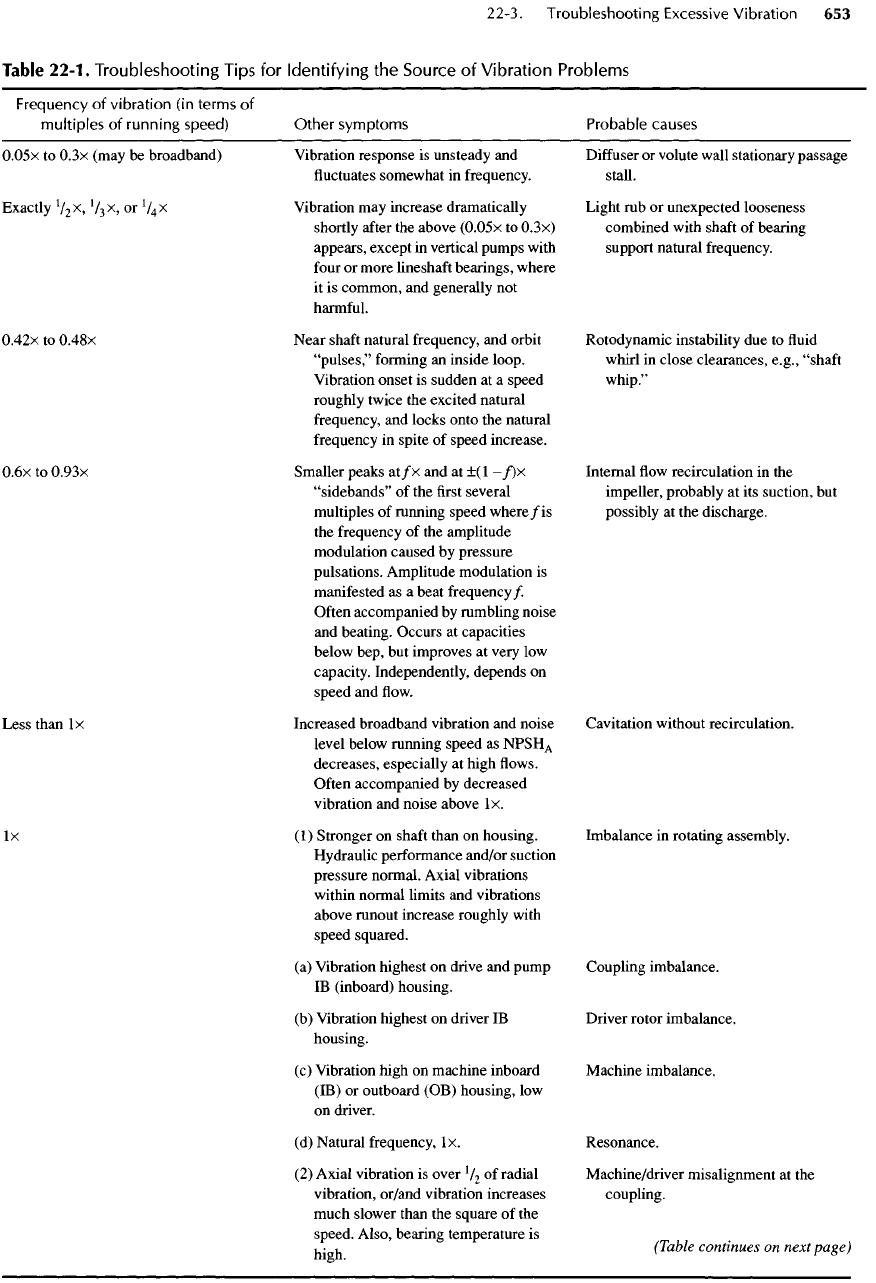
Frequency
of
vibration
(in
terms
of
multiples
of
running
speed)
0.05x
to
0.3x (may
be
broadband)
Exactly
V
2
X,
V
3
X,
or
V
4
X
0.42x
to
0.48x
0.6x
to
0.93x
Less than
Ix
Ix
Other symptoms
Vibration
response
is
unsteady
and
fluctuates
somewhat
in
frequency.
Vibration
may
increase dramatically
shortly
after
the
above
(0.05x
to
0.3x)
appears, except
in
vertical pumps with
four
or
more lineshaft bearings, where
it
is
common,
and
generally
not
harmful.
Near
shaft
natural
frequency,
and
orbit
"pulses,"
forming
an
inside loop.
Vibration
onset
is
sudden
at a
speed
roughly
twice
the
excited natural
frequency,
and
locks onto
the
natural
frequency
in
spite
of
speed increase.
Smaller peaks
at/x
and at
±(1
-/)x
"sidebands"
of the first
several
multiples
of
running speed
where/
is
the
frequency
of the
amplitude
modulation caused
by
pressure
pulsations. Amplitude modulation
is
manifested
as a
beat
frequency/.
Often
accompanied
by
rumbling noise
and
beating. Occurs
at
capacities
below bep,
but
improves
at
very
low
capacity. Independently, depends
on
speed
and flow.
Increased broadband vibration
and
noise
level below running speed
as
NPSH
A
decreases, especially
at
high
flows.
Often
accompanied
by
decreased
vibration
and
noise above
Ix.
(1)
Stronger
on
shaft
than
on
housing.
Hydraulic
performance and/or suction
pressure normal. Axial vibrations
within
normal limits
and
vibrations
above runout increase roughly with
speed squared.
(a)
Vibration highest
on
drive
and
pump
IB
(inboard) housing.
(b)
Vibration highest
on
driver
IB
housing.
(c)
Vibration high
on
machine inboard
(IB)
or
outboard (OB) housing,
low
on
driver.
(d)
Natural frequency,
Ix.
(2)
Axial vibration
is
over
V
2
of
radial
vibration, or/and vibration increases
much
slower than
the
square
of the
speed. Also, bearing temperature
is
high.
Probable
causes
Diffuser
or
volute wall stationary passage
stall.
Light
rub or
unexpected looseness
combined
with
shaft
of
bearing
support
natural frequency.
Rotodynamic instability
due to fluid
whirl
in
close clearances, e.g., "shaft
whip."
Internal
flow
recirculation
in the
impeller,
probably
at its
suction,
but
possibly
at the
discharge.
Cavitation
without recirculation.
Imbalance
in
rotating assembly.
Coupling imbalance.
Driver rotor imbalance.
Machine imbalance.
Resonance.
Machine/driver misalignment
at the
coupling.
(
Table
continues
on
next
page)
Table
22-1.
Troubleshooting
Tips
for
Identifying
the
Source
of
Vibration
Problems
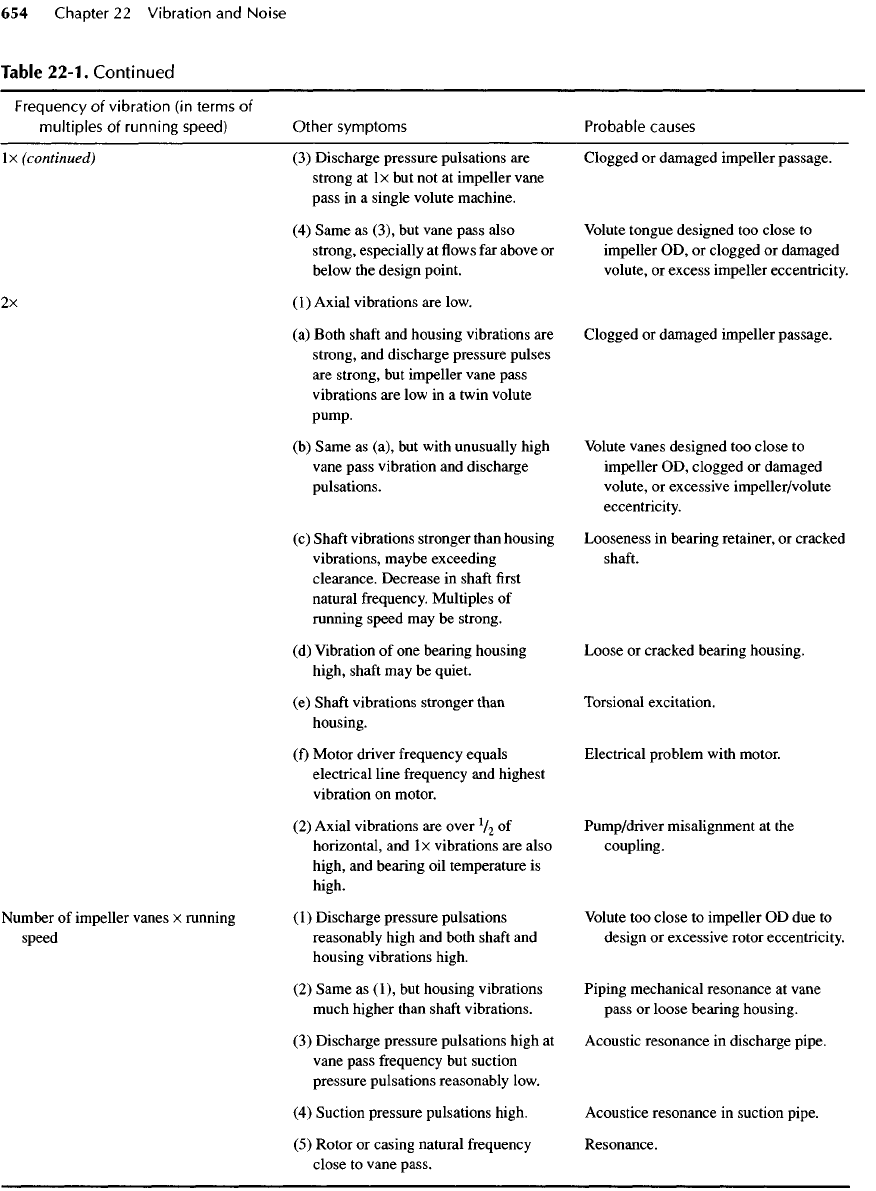
Table
22-1.
Continued
Frequency
of
vibration
(in
terms
of
multiples
of
running
speed)
Ix
(continued)
2x
Number
of
impeller vanes
x
running
speed
Other symptoms
(3)
Discharge pressure pulsations
are
strong
at
Ix
but not at
impeller
vane
pass
in a
single volute machine.
(4)
Same
as
(3),
but
vane pass also
strong, especially
at flows far
above
or
below
the
design point.
(1)
Axial vibrations
are
low.
(a)
Both
shaft
and
housing vibrations
are
strong,
and
discharge pressure pulses
are
strong,
but
impeller vane pass
vibrations
are low in a
twin volute
pump.
(b)
Same
as
(a),
but
with
unusually
high
vane
pass vibration
and
discharge
pulsations.
(c)
Shaft
vibrations stronger than housing
vibrations, maybe exceeding
clearance. Decrease
in
shaft
first
natural
frequency. Multiples
of
running
speed
may be
strong.
(d)
Vibration
of one
bearing housing
high,
shaft
may be
quiet.
(e)
Shaft
vibrations
stronger
than
housing.
(f)
Motor driver
frequency
equals
electrical line
frequency
and
highest
vibration
on
motor.
(2)
Axial vibrations
are
over
1
I
2
of
horizontal,
and
Ix
vibrations
are
also
high,
and
bearing
oil
temperature
is
high.
(1)
Discharge pressure pulsations
reasonably high
and
both
shaft
and
housing
vibrations high.
(2)
Same
as
(1),
but
housing vibrations
much
higher than
shaft
vibrations.
(3)
Discharge pressure pulsations high
at
vane
pass
frequency
but
suction
pressure pulsations reasonably low.
(4)
Suction pressure pulsations high.
(5)
Rotor
or
casing natural
frequency
close
to
vane pass.
Probable
causes
Clogged
or
damaged impeller passage.
Volute
tongue designed
too
close
to
impeller
OD, or
clogged
or
damaged
volute,
or
excess impeller eccentricity.
Clogged
or
damaged impeller passage.
Volute
vanes designed
too
close
to
impeller
OD,
clogged
or
damaged
volute,
or
excessive impeller/volute
eccentricity.
Looseness
in
bearing retainer,
or
cracked
shaft.
Loose
or
cracked bearing housing.
Torsional
excitation.
Electrical problem with motor.
Pump/driver misalignment
at the
coupling.
Volute
too
close
to
impeller
OD due to
design
or
excessive rotor eccentricity.
Piping mechanical resonance
at
vane
pass
or
loose
bearing housing.
Acoustic
resonance
in
discharge pipe.
Acoustice resonance
in
suction pipe.
Resonance.
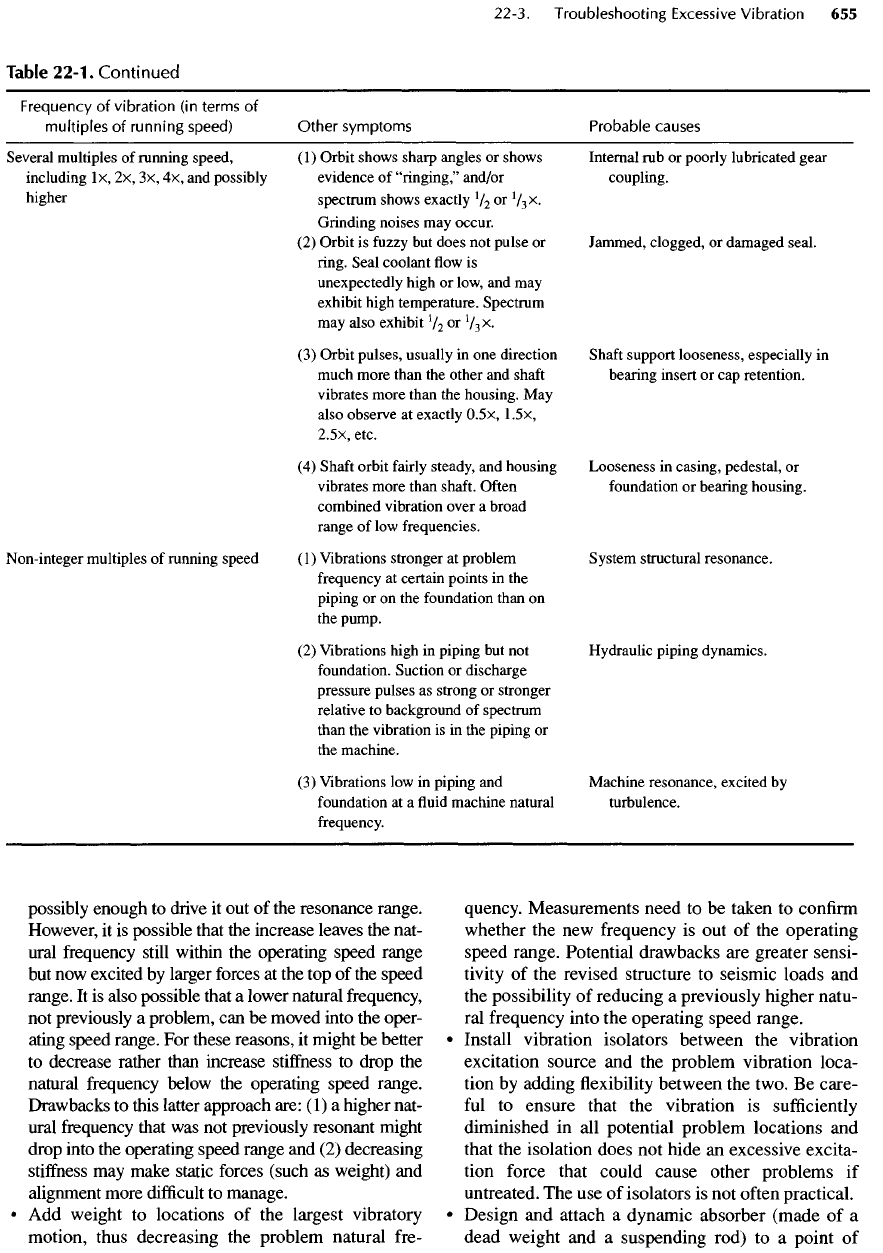
possibly
enough
to
drive
it out of the
resonance range.
However,
it is
possible that
the
increase leaves
the
nat-
ural
frequency
still within
the
operating speed range
but
now
excited
by
larger
forces
at the top of the
speed
range.
It is
also possible that
a
lower natural
frequency,
not
previously
a
problem,
can be
moved into
the
oper-
ating
speed range.
For
these reasons,
it
might
be
better
to
decrease rather than increase
stiffness
to
drop
the
natural
frequency
below
the
operating speed range.
Drawbacks
to
this latter approach are:
(1) a
higher nat-
ural
frequency
that
was not
previously resonant might
drop
into
the
operating speed range
and (2)
decreasing
stiffness
may
make static
forces
(such
as
weight)
and
alignment
more
difficult
to
manage.
• Add
weight
to
locations
of the
largest vibratory
motion,
thus decreasing
the
problem natural fre-
quency.
Measurements need
to be
taken
to
confirm
whether
the new
frequency
is out of the
operating
speed range. Potential drawbacks
are
greater sensi-
tivity
of the
revised structure
to
seismic loads
and
the
possibility
of
reducing
a
previously higher natu-
ral
frequency
into
the
operating speed range.
•
Install vibration isolators between
the
vibration
excitation source
and the
problem vibration loca-
tion
by
adding
flexibility
between
the
two.
Be
care-
ful
to
ensure that
the
vibration
is
sufficiently
diminished
in all
potential problem locations
and
that
the
isolation does
not
hide
an
excessive excita-
tion force that could cause other problems
if
untreated.
The use of
isolators
is not
often
practical.
•
Design
and
attach
a
dynamic absorber (made
of a
dead weight
and a
suspending rod)
to a
point
of
Table
22-1.
Continued
Frequency
of
vibration
(in
terms
of
multiples
of
running
speed)
Several multiples
of
running speed,
including
Ix,
2x, 3x, 4x, and
possibly
higher
Non-integer multiples
of
running speed
Other symptoms
(1)
Orbit shows sharp angles
or
shows
evidence
of
"ringing,"
and/or
spectrum shows exactly
1
J
2
or
l
/
3
x.
Grinding noises
may
occur.
(2)
Orbit
is
fuzzy
but
does
not
pulse
or
ring. Seal coolant
flow is
unexpectedly high
or
low,
and may
exhibit
high temperature. Spectrum
may
also exhibit
1
I
2
or
l
/
3
x.
(3)
Orbit pulses, usually
in one
direction
much
more than
the
other
and
shaft
vibrates
more than
the
housing.
May
also observe
at
exactly 0.5x, 1.5x,
2.5x, etc.
(4)
Shaft
orbit
fairly
steady,
and
housing
vibrates more than
shaft.
Often
combined vibration over
a
broad
range
of low
frequencies.
(1)
Vibrations stronger
at
problem
frequency
at
certain points
in the
piping
or on the
foundation than
on
the
pump.
(2)
Vibrations high
in
piping
but not
foundation.
Suction
or
discharge
pressure pulses
as
strong
or
stronger
relative
to
background
of
spectrum
than
the
vibration
is in the
piping
or
the
machine.
(3)
Vibrations
low in
piping
and
foundation
at a fluid
machine natural
frequency.
Probable
causes
Internal
rub or
poorly lubricated gear
coupling.
Jammed, clogged,
or
damaged
seal.
Shaft
support
looseness,
especially
in
bearing insert
or cap
retention.
Looseness
in
casing, pedestal,
or
foundation
or
bearing housing.
System structural resonance.
Hydraulic
piping dynamics.
Machine resonance, excited
by
turbulence.
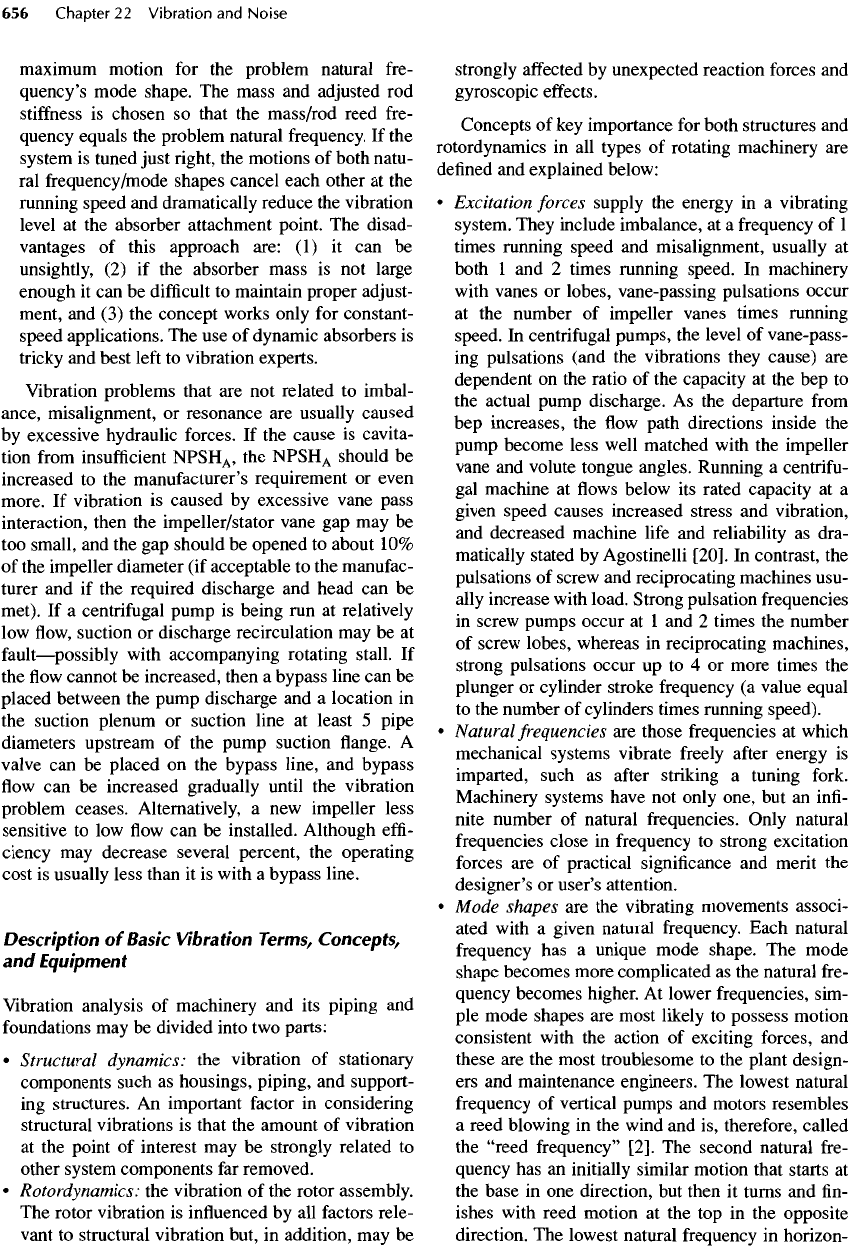
maximum
motion
for the
problem natural fre-
quency's mode shape.
The
mass
and
adjusted
rod
stiffness
is
chosen
so
that
the
mass/rod reed fre-
quency equals
the
problem natural frequency.
If the
system
is
tuned just right,
the
motions
of
both natu-
ral
frequency
/mode
shapes cancel each other
at the
running
speed
and
dramatically reduce
the
vibration
level
at the
absorber attachment point.
The
disad-
vantages
of
this approach are:
(1) it can be
unsightly,
(2) if the
absorber mass
is not
large
enough
it can be
difficult
to
maintain proper adjust-
ment,
and (3) the
concept works only
for
constant-
speed applications.
The use of
dynamic absorbers
is
tricky
and
best
left
to
vibration experts.
Vibration
problems that
are not
related
to
imbal-
ance, misalignment,
or
resonance
are
usually caused
by
excessive hydraulic forces.
If the
cause
is
cavita-
tion
from
insufficient
NPSH
A
,
the
NPSH
A
should
be
increased
to the
manufacturer's requirement
or
even
more.
If
vibration
is
caused
by
excessive vane pass
interaction, then
the
impeller/stator vane
gap may be
too
small,
and the gap
should
be
opened
to
about
10%
of
the
impeller diameter
(if
acceptable
to the
manufac-
turer
and if the
required discharge
and
head
can be
met).
If a
centrifugal
pump
is
being
run at
relatively
low
flow,
suction
or
discharge recirculation
may be at
fault
—
possibly
with accompanying rotating stall.
If
the
flow
cannot
be
increased, then
a
bypass line
can be
placed between
the
pump discharge
and a
location
in
the
suction plenum
or
suction line
at
least
5
pipe
diameters upstream
of the
pump suction
flange. A
valve
can be
placed
on the
bypass line,
and
bypass
flow
can
be
increased gradually until
the
vibration
problem ceases. Alternatively,
a new
impeller less
sensitive
to low flow can be
installed. Although
effi-
ciency
may
decrease several percent,
the
operating
cost
is
usually less than
it is
with
a
bypass line.
Description
of
Basic
Vibration
Terms,
Concepts,
and
Equipment
Vibration analysis
of
machinery
and its
piping
and
foundations
may be
divided into
two
parts:
•
Structural dynamics:
the
vibration
of
stationary
components such
as
housings, piping,
and
support-
ing
structures.
An
important factor
in
considering
structural
vibrations
is
that
the
amount
of
vibration
at
the
point
of
interest
may be
strongly related
to
other system components
far
removed.
•
Rotordynamics:
the
vibration
of the
rotor assembly.
The
rotor vibration
is
influenced
by all
factors
rele-
vant
to
structural vibration but,
in
addition,
may be
strongly
affected
by
unexpected reaction forces
and
gyroscopic
effects.
Concepts
of key
importance
for
both structures
and
rotordynamics
in all
types
of
rotating machinery
are
defined
and
explained below:
•
Excitation forces supply
the
energy
in a
vibrating
system. They include imbalance,
at a
frequency
of 1
times running speed
and
misalignment, usually
at
both
1 and 2
times running speed.
In
machinery
with vanes
or
lobes, vane-passing pulsations occur
at
the
number
of
impeller vanes times running
speed.
In
centrifugal pumps,
the
level
of
vane-pass-
ing
pulsations (and
the
vibrations they cause)
are
dependent
on the
ratio
of the
capacity
at the bep to
the
actual pump discharge.
As the
departure
from
bep
increases,
the flow
path directions inside
the
pump
become less well matched with
the
impeller
vane
and
volute tongue angles. Running
a
centrifu-
gal
machine
at flows
below
its
rated capacity
at a
given speed causes increased stress
and
vibration,
and
decreased machine
life
and
reliability
as
dra-
matically stated
by
Agostinelli
[2O].
In
contrast,
the
pulsations
of
screw
and
reciprocating machines usu-
ally
increase with load. Strong pulsation frequencies
in
screw pumps occur
at 1 and 2
times
the
number
of
screw lobes, whereas
in
reciprocating machines,
strong pulsations occur
up to 4 or
more times
the
plunger
or
cylinder stroke frequency
(a
value equal
to the
number
of
cylinders times running speed).
•
Natural frequencies
are
those frequencies
at
which
mechanical systems vibrate
freely
after
energy
is
imparted, such
as
after
striking
a
tuning
fork.
Machinery systems have
not
only one,
but an
infi-
nite number
of
natural frequencies. Only natural
frequencies
close
in
frequency
to
strong excitation
forces
are of
practical significance
and
merit
the
designer's
or
user's attention.
•
Mode
shapes
are the
vibrating movements associ-
ated with
a
given natural
frequency.
Each natural
frequency
has a
unique mode shape.
The
mode
shape becomes more complicated
as the
natural fre-
quency becomes higher.
At
lower frequencies, sim-
ple
mode shapes
are
most likely
to
possess motion
consistent with
the
action
of
exciting forces,
and
these
are the
most troublesome
to the
plant design-
ers and
maintenance engineers.
The
lowest natural
frequency
of
vertical pumps
and
motors resembles
a
reed blowing
in the
wind
and is,
therefore, called
the
"reed
frequency"
[2].
The
second natural fre-
quency
has an
initially similar motion that starts
at
the
base
in one
direction,
but
then
it
turns
and fin-
ishes with reed motion
at the top in the
opposite
direction.
The
lowest natural frequency
in
horizon-
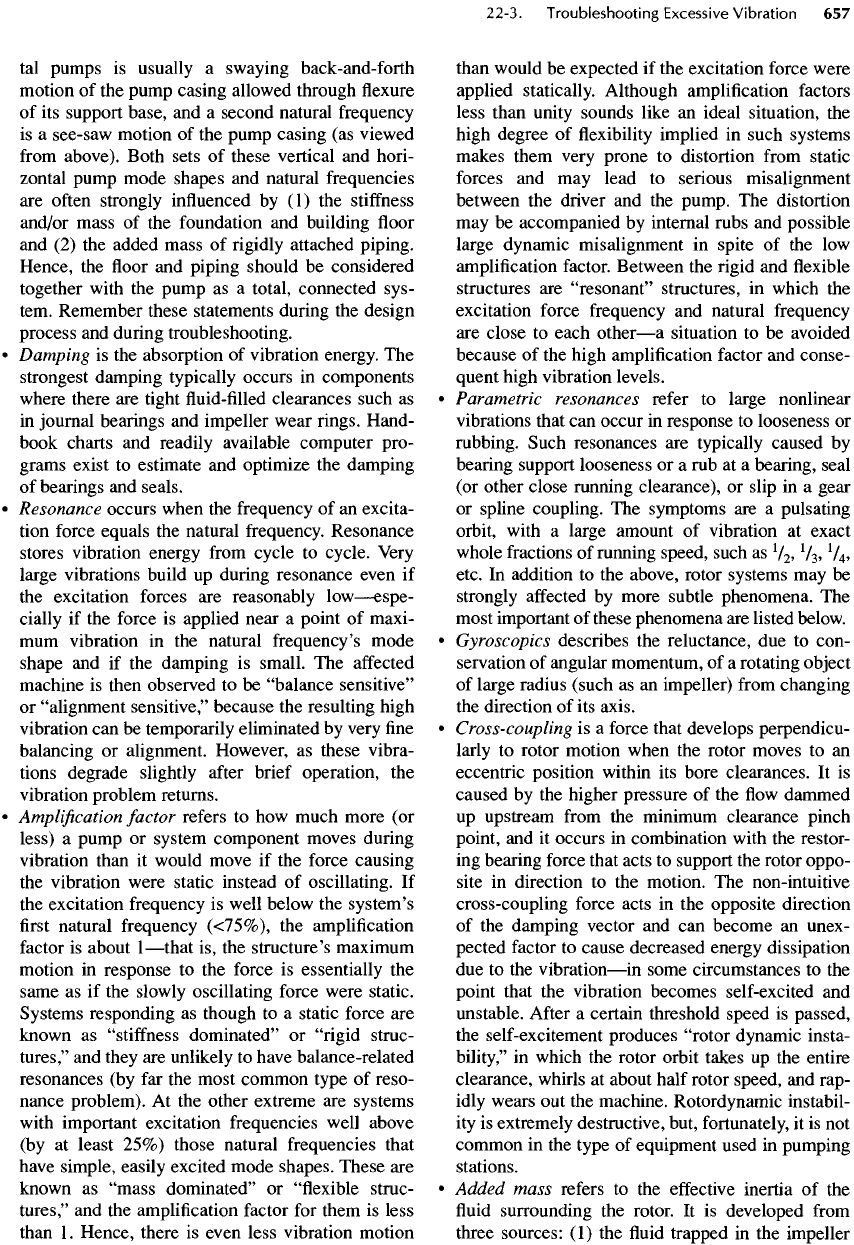
tal
pumps
is
usually
a
swaying
back-and-forth
motion
of the
pump casing allowed through
flexure
of
its
support base,
and a
second natural frequency
is
a
see-saw motion
of the
pump casing
(as
viewed
from
above). Both sets
of
these vertical
and
hori-
zontal
pump mode shapes
and
natural frequencies
are
often
strongly
influenced
by (1) the
stiffness
and/or mass
of the
foundation
and
building
floor
and
(2) the
added mass
of rigidly
attached piping.
Hence,
the floor and
piping should
be
considered
together
with
the
pump
as a
total, connected sys-
tem.
Remember these statements during
the
design
process
and
during troubleshooting.
•
Damping
is the
absorption
of
vibration energy.
The
strongest damping typically occurs
in
components
where there
are
tight
fluid-filled
clearances such
as
in
journal bearings
and
impeller wear rings. Hand-
book charts
and
readily available computer pro-
grams
exist
to
estimate
and
optimize
the
damping
of
bearings
and
seals.
•
Resonance occurs when
the
frequency
of an
excita-
tion
force equals
the
natural
frequency.
Resonance
stores vibration energy
from
cycle
to
cycle.
Very
large vibrations build
up
during resonance even
if
the
excitation forces
are
reasonably
low
—
espe-
cially
if the
force
is
applied near
a
point
of
maxi-
mum
vibration
in the
natural frequency's mode
shape
and if the
damping
is
small.
The
affected
machine
is
then observed
to be
"balance
sensitive"
or
"alignment sensitive," because
the
resulting high
vibration
can be
temporarily eliminated
by
very
fine
balancing
or
alignment. However,
as
these vibra-
tions degrade slightly
after
brief operation,
the
vibration
problem returns.
•
Amplification
factor refers
to how
much more
(or
less)
a
pump
or
system component moves during
vibration than
it
would move
if the
force causing
the
vibration were static instead
of
oscillating.
If
the
excitation frequency
is
well below
the
system's
first
natural
frequency
(<75%),
the
amplification
factor
is
about
1
—
that
is, the
structure's maximum
motion
in
response
to the
force
is
essentially
the
same
as if the
slowly oscillating force were static.
Systems
responding
as
though
to a
static force
are
known
as
"stiffness
dominated"
or
"rigid
struc-
tures,"
and
they
are
unlikely
to
have balance-related
resonances
(by far the
most common type
of
reso-
nance problem).
At the
other extreme
are
systems
with
important excitation frequencies well above
(by
at
least 25%) those natural frequencies that
have
simple, easily excited mode shapes. These
are
known
as
"mass
dominated"
or
"flexible struc-
tures,"
and the
amplification factor
for
them
is
less
than
1.
Hence, there
is
even less vibration motion
than
would
be
expected
if the
excitation force were
applied statically. Although amplification factors
less
than unity sounds like
an
ideal
situation,
the
high
degree
of flexibility
implied
in
such systems
makes them very prone
to
distortion
from
static
forces
and may
lead
to
serious misalignment
between
the
driver
and the
pump.
The
distortion
may
be
accompanied
by
internal rubs
and
possible
large dynamic misalignment
in
spite
of the low
amplification
factor. Between
the
rigid
and flexible
structures
are
"resonant"
structures,
in
which
the
excitation force frequency
and
natural frequency
are
close
to
each
other
—
a
situation
to be
avoided
because
of the
high amplification factor
and
conse-
quent
high vibration levels.
•
Parametric resonances refer
to
large nonlinear
vibrations that
can
occur
in
response
to
looseness
or
rubbing.
Such resonances
are
typically caused
by
bearing support looseness
or a rub at a
bearing, seal
(or
other close running clearance),
or
slip
in a
gear
or
spline coupling.
The
symptoms
are a
pulsating
orbit, with
a
large amount
of
vibration
at
exact
whole fractions
of
running speed, such
as
l
/
2
,
1
I^
1
I^
etc.
In
addition
to the
above, rotor systems
may be
strongly
affected
by
more subtle phenomena.
The
most important
of
these phenomena
are
listed below.
•
Gyroscopics describes
the
reluctance,
due to
con-
servation
of
angular momentum,
of a
rotating object
of
large radius (such
as an
impeller)
from
changing
the
direction
of its
axis.
•
Cross-coupling
is a
force that develops perpendicu-
larly
to
rotor motion when
the
rotor moves
to an
eccentric position within
its
bore
clearances.
It is
caused
by the
higher pressure
of the flow
dammed
up
upstream
from
the
minimum clearance pinch
point,
and it
occurs
in
combination with
the
restor-
ing
bearing force that acts
to
support
the
rotor oppo-
site
in
direction
to the
motion.
The
non-intuitive
cross-coupling force acts
in the
opposite
direction
of
the
damping vector
and can
become
an
unex-
pected factor
to
cause decreased energy dissipation
due
to the
vibration
—
in
some circumstances
to the
point that
the
vibration becomes self-excited
and
unstable.
After
a
certain threshold speed
is
passed,
the
self-excitement produces
"rotor
dynamic insta-
bility,"
in
which
the
rotor orbit takes
up the
entire
clearance, whirls
at
about half rotor speed,
and
rap-
idly
wears
out the
machine. Rotordynamic instabil-
ity
is
extremely destructive, but, fortunately,
it is not
common
in the
type
of
equipment used
in
pumping
stations.
•
Added mass refers
to the
effective
inertia
of the
fluid
surrounding
the
rotor.
It is
developed
from
three sources:
(1) the fluid
trapped
in the
impeller
